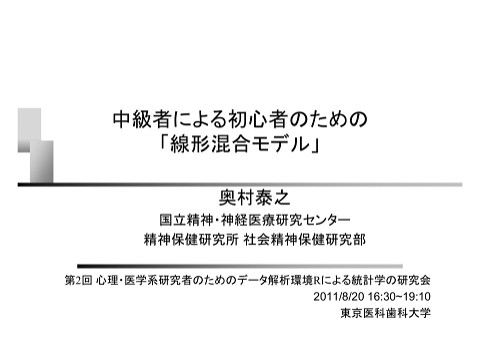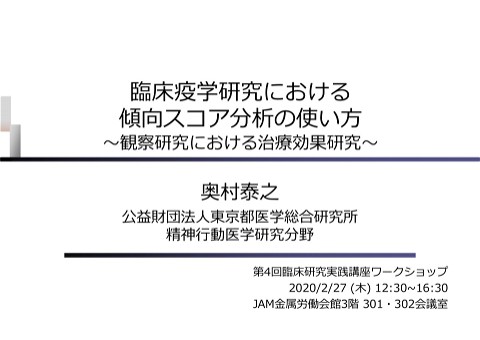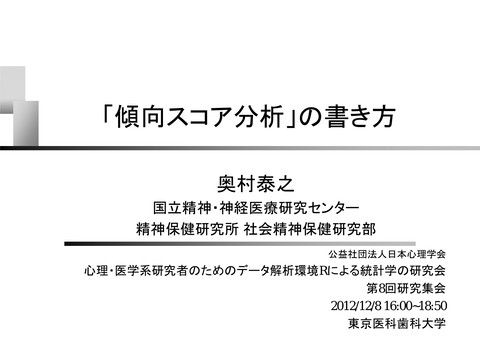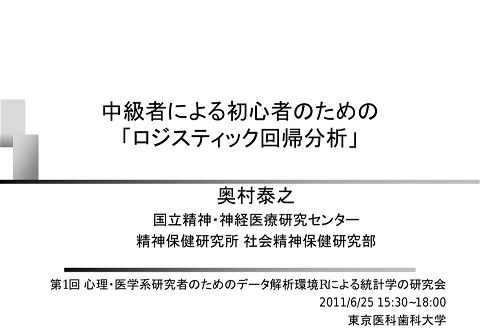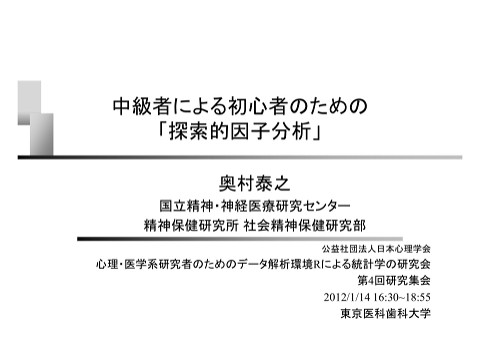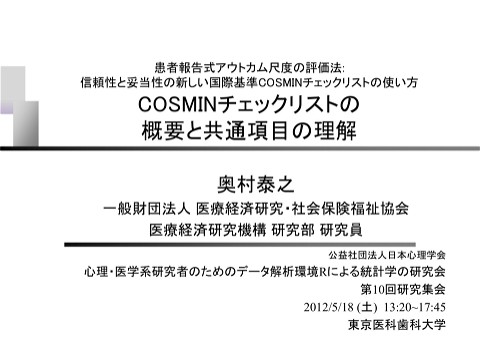データベース研究の報告
2.4K Views
May 24, 22
スライド概要
関連スライド
各ページのテキスト
データベース研究の報告 公益財団法人 東京都医学総合研究所 精神行動医学研究分野 心の健康プロジェクト 奥村 泰之 臨床疫学研究における報告の質向上のための統計学の研究会 第32回研究集会 2018/10/13 (土) 13:30~17:55 お茶の水医学会館 9階大会議室
発表構成 ◼はじめに ◼ISPEの報告ガイドライン ◆A. データ源 ◆B. 研究法の全体像 ◆C. 適格基準 ◆D. 曝露の定義 ◆E. 追跡期間 ◆F. アウトカムの定義 ◆G. 共変量の定義 ◆H. 対照群のサンプリング 2
医療情報のデジタル化・標準化 内閣官房: http://www.pref.kanagawa.jp/docs/mv4/globalstrategy/documents/20180529_hcnfsymposium_naikakufu.pdf3
医療情報の(独立)データベース化 堀田知光: https://www.kantei.go.jp/jp/singi/kenkouiryou/sanyokaigou/dai7/t5.pdf 4
医療技術評価機関におけるRWD*の活用 *リアルワールドデータ 国 (評価機関名) スウェーデン 英国 (TLV) (NICE) ドイツ (IQWig) フランス (HAS) イタリア (AIFA) オランダ (ZIN) 初回の保険償還での議論におい て,希少疾患などの限定された 〇 状況で,RWDによる効能に関す る結論づけ 〇 × NA NA 〇 薬剤経済的分析において,RWD による効能以外の情報 (発症率, 有病率,直接費用,間接費用, 〇 資源利用,アドヒアランスなど) に関する結論づけ 〇 NA 〇 〇 〇 条件付け償還において,RWDに よる効果,費用対効果,または NA その両方を検討することへの選 好 NA NA 〇 〇 × Makady A et al: Value Health. 2017 Apr;20(4):520-532. 5
安全性比較研究におけるRWD*の活用事例 *リアルワールドデータ 静注デキストラ ン鉄 他の静注用鉄剤 アナフィラ キシー反応 反応なし アナフィラ キシー反応 反応なし デキストラン鉄による アナフィラキシー反応 のオッズ比 Wang C et al: JAMA. 2015 Nov 17;314(19):2062-8. 6
効果比較研究におけるRWD*の活用事例 *リアルワールドデータ スタチン 処方なし スタチン 処方なし 骨折群 マッチング (年齢・性別など) 対照群 スタチンによる大腿 骨骨折のオッズ比 Cook A et al: Surg Obes Relat Dis. 2018 Apr 17. pii: S1550-7289(18)30175-8. 7
スタチンによる骨折予防効果,再現性がない 方法 データ源 Meier et al (2000) General Practice Research Database 症例対照研究 研究法 オッズ比 0.12 (0.04, 0.41) (95%信頼区 間) 曝露の定義 インデックス日 (イベント 発現日) から30日未満にお けるスタチン処方 マッチング 年齢 (5歳刻み) など 因子 Meier CR et al: JAMA. 2000 Jun 28;283(24):3205-10. van Staa TP et al: JAMA. 2001 Apr 11;285(14):1850-5. van Staa et al (2001) General Practice Research Database 症例対照研究 0.59 (0.31, 1.13) インデックス日 (イベン ト発現日) から6か月以内 におけるスタチン処方 年齢 (各歳) など 8
再現性の検証 リスクの持続期間が短い と効果が大きい 5歳刻みだと 残余交絡の影響で効果が大きい マッチング因子 オッズ比 (95%信頼区間) 年齢 (5歳刻み) 0.37 (0.27, 0.52) 年齢 (各歳) de Vries F et al: Int J Epidemiol. 2006 Oct;35(5):1301-8 0.58 (0.43, 0.79) 9
透明性の高い記述(transparent reporting), 検証の前提 再生性と再現性の担保 透明性の 高い記述 定義の妥当性の評価 研究間の結果が一致しない 原因の理解 Wang SV et al: Value Health. 2017 Sep;20(8):1009-1022. 10
透明性の低い記述が蔓延 泌尿器学のデータベース研究56論文 評価項目 報告率 1. 調査対象を選択する方法 (コードやアルゴリズム) を詳細に提示すること 61% 2. 主要な変数を同定するために使ったコードやアルゴ リズムの完全なリストを記載すること ●曝露 63% ●アウトカム 46% ●共変量と効果修飾因子 16% 3. 研究計画書,生データ,プログラミングコードなど 50% の補足的情報へのアクセス方法を記載すること Welk B et al: Can Urol Assoc J. 2017 Mar-Apr;11(3-4):136-141 11
再生性と再現性 質の高い研究の 必要条件 直接的追試(direct replication) ある特定の研究の再生性(reproducibility) 概念的追試(conceptual replication) ある研究結果の再現性(replicability) 一般化可能性の 示唆 Wang SV et al: Value Health. 2017 Sep;20(8):1009-1022. Nosek BA et al: Elife. 2017 Jan 19;6. pii: e23383. データ源 方法 同じ 同じ 異なる 同じ 異なる 同じ 異なる 異なる 12
再生性と再現性の類推法 類似の結果を得られたとす る基準は不明瞭 類推 ✓ ✓ ✓ ✓ ✓ 効果の方向性は等しい? 効果の大きさは近似? 信頼区間の間に,効果量が収まる? 2つの結果を統合しても関連が得られる? 2つの結果は一貫している? Nosek BA et al: Elife. 2017 Jan 19;6. pii: e23383. 13
オープンサイエンス運動 研究の 事前登録 透明性の オープンサ 高い報告 イエンス データ共有 研究計画書 の公開 Wang SV et al: Value Health. 2017 Sep;20(8):1009-1022. 14
データベース研究における取り組み プロセスに関する透明性 ➡何を計画したか 実施に関する透明性 ➡実際に何をしたか Berger ML et al: Value Health. 2017 Sep;20(8):1003-1008. Wang SV et al: Value Health. 2017 Sep;20(8):1009-1022. 15
既存の報告ガイドライン, 再生性の向上に寄与しない Wang SV et al: Value Health. 2017 Sep;20(8):1009-1022. 16
ISPE報告ガイドライン透明性の3ステップ, 整然化に焦点化 医療提供 電子カルテ, レセプト情 報など Step1: 加工 ID 医薬品名 数量 患者情報 ID 性別 年齢 ID 曝露 アウトカム 共変量 Step3: 解析 Step2: 整然化 リレーショナルデータ 医薬品情報 分析データ 報告 傷病情報 ID 表1 表2 図 傷病名 診療開始日 日数 Wang SV et al: Value Health. 2017 Sep;20(8):1009-1022. 17
ISPE報告ガイドラインの構成 大項目 項目数 A. データ源 8 B. 研究法の全体像 1 C. 適格基準 12 D. 曝露の定義 5 E. 追跡期間 2 F. アウトカムの定義 3 G. 共変量の定義 4 H. 対照群の抽出法 3 I. 統計ソフトウェア 1 Wang SV et al: Value Health. 2017 Sep;20(8):1009-1022. 18
ISPE報告ガイドライン A. データ源 19
データ源の記載事項 記載事項 A1. データ源の名称とデータ提供の組織名 A2. 常に更新されているデータ源からデータを抽出した日 (あるいはバージョ ン番号) (例: ベンダーが研究目的にデータを切り出した日) A3. 研究者がアクセスできるデータが,ベンダーが持つデータの一部である 場合,適用した検索/抽出基準 A4. 研究に使用したデータの期間 A5. 情報の領域 (例: 医事会計システム,電子カルテ,入院・外来,プライマ リケア・セカンダリケア,薬局,検査,レジストリ) A6. レコードリンケージあるいは通常データベースに含まれていないデータ (例: 診療録調査,調査データ) A7. 欠測値や異常値の処理法 (データ源レベルでの処理あるいはプロジェクト ごとの処理) A8. 標準化された形式へのデータの変換法 20
A1. データ提供者 ◼記載事項 ◆データ源の名称とデータ提供の組織名 ◼事例 ⚫ Our cohort study was conducted in commercially insured patients using the MarketScan health care database provided by Truven (January 1, 2003, through September 30, 2009).[1] ⚫ We used the 2000-2014 Truven Health Analytics MarketScan Commercial Claims and Encounters databases covering the years 2000 to 2014.[2] [1] Fralick M et al: JAMA Intern Med. 2018 Jan 1;178(1):55-63. [2] Seamans MJ et al: JAMA Intern Med. 2018 Jan 1;178(1):102-109. 21
A2. データ抽出日 ◼記載事項 ◆常に更新されているデータ源からデータを抽 出した日 (あるいはバージョン番号) (例: ベン ダーが研究目的にデータを切り出した日) ◼事例(がみあたらない) ⚫ The source data for this research study was cut by [data vendor] on January 1st, 2017. The study included administrative claims from Jan 1st 2005 to Dec 31st 2015. Wang SV et al: Value Health. 2017 Sep;20(8):1009-1022. 22
データ抽出日の重要性 抽出日により保険者数 が異なる 複数保険者のDB 複数保険者のDB (2017年時点) (2018年時点) A A B B C C D E 2012 2016 2012 2016 23
A3. データ抽出法 ◼記載事項 C. 適格基準と重複するため 必要性には疑問 ◆ 研究者がアクセスできるデータが,ベンダー が持つデータの一部である場合,適用した検索 /抽出基準 ◼事例(がみあたらない) 24
A4. データ源の範囲 ◼記載事項 ◆研究に使用したデータの期間 ◼事例 ⚫ Our cohort study was conducted in commercially insured patients using the MarketScan health care database provided by Truven (January 1, 2003, through September 30, 2009).[1] ⚫ We used the 2000-2014 Truven Health Analytics MarketScan Commercial Claims and Encounters databases covering the years 2000 to 2014.[2] [1] Fralick M et al: JAMA Intern Med. 2018 Jan 1;178(1):55-63. [2] Seamans MJ et al: JAMA Intern Med. 2018 Jan 1;178(1):102-109. 25
A5. データの種類 ◼記載事項 ◆情報の領域 (例: 医事会計システム,電子カル テ,入院・外来,プライマリケア・セカンダリ ケア,薬局,検査,レジストリ) ◼事例 ⚫ This database includes inpatient, outpatient, and pharmaceutical claims of more than 75 million employees, retirees, and dependents from more than 150 payers across all states.[1] ⚫ MarketScan contains standardized, deidentified, person-level information on enrollment, paid inpatient and outpatient services and procedures, and outpatient pharmacy dispensing claims of employer-sponsored commercial insurance beneficiaries, their spouses, and dependents.[2] [1] Fralick M et al: JAMA Intern Med. 2018 Jan 1;178(1):55-63. [2] Seamans MJ et al: JAMA Intern Med. 2018 Jan 1;178(1):102-109. 26
A6. レコードリンケージ ◼記載事項 ◆レコードリンケージあるいは通常データベー スに含まれていないデータ (例: 診療録調査, 調査データ) ◼事例 ⚫ We used the United States Renal Data System (USRDS), a national registry for ESRD [end-stage renal disease], linked to Medicare claims to define a cohort of beneficiaries with ESRD who received their first LVAD between 2003 and 2013.[1] ⚫ Data for this study came from PT-MED [Project Talent–Medicare], a linkage of sociobehavioral data collected from high school students in 1960 to participants’ Medicare claims and expenditures data.[2] [1] Bansal N et al: JAMA Intern Med. 2018 Feb 1;178(2):204-209. [2] Huang et al: JAMA Network Open. 2018;1(5):e181726. 27
A7. データクリーニング ◼記載事項 ◆欠測値や異常値の処理法 (データ源レベルでの 処理あるいはプロジェクトごとの処理) ◼事例(がみあたらない) ⚫ (データ源レベル) All dispensing claims that were missing day’s supply or had 0 days’ supply were removed from the source data tables. ⚫ (プロジェクトレベル) When calculating duration of exposure for our study population, we ignored dispensation claims that were missing or had 0 days’ supply. Wang SV et al: Value Health. 2017 Sep;20(8):1009-1022. 28
A8. 標準化形式への変換法 ◼記載事項 ◆標準化された形式へのデータの変換法 ◼事例 ⚫ We used three US claims databases: 1. Truven Commercial Claims and Encounters (CCAE), 2. TruvenMarketScan Medicare Supplemental Beneficiaries (MDCR), and 3. OptumInsight‘s de‐identified ClinformaticsTMDatamart (Optum). …(中略)… All the databases were converted to the Observational Medical Outcomes Partnership (OMOP) common data model (CDM) (Stang et al., 2010). One advantage of a standardized format and content is that the same analytic code can be applied to all three databases (Voss et al., 2015). Cepeda MS et al: Depress Anxiety. 2018 Mar;35(3):220-228. 29
OMOP共通データモデル Cho et al: https://slideplayer.com/slide/12579989/ 30
ISPE報告ガイドライン B. 研究法の全体像 31
B1. デザインダイアグラム ◼記載事項 ◆主要な時間として,加入期間,インデックス 日 (コホートへの組み入れ日),共変量の測定期 間,追跡期間,曝露の測定期間,イベント発現 日,曝露のウォッシュアウト,アウトカムのウ オッシュアウト,などを図示 32
主要な時間の定義① 項目 定義 加入期間 コホートへの組み入れより前に,参加 者がデータベースに含まれていること を保証する期間 Enrollment window 共変量の測定期間 Covariate assessment window 追跡期間 Follow-up window 共変量を測定する期間 (中間変数となら ないよう,インデックス日以前とする) 参加者が曝露によるアウトカム発現の アットリスクとなる,コホートへの組 み入れから追跡する期間 Wang SV et al: Value Health. 2017 Sep;20(8):1009-1022. 33
主要な時間の定義② 項目 定義 曝露の測定期間 曝露を測定する期間 (曝露は,その期間 の最終時点に定義する)。新規使用者な ど曝露によりコホートへの組み入れを 定義する場合,曝露の測定は期間では なく時点となる。コホートへの組み入 れ後に曝露を定義する場合,曝露の後 に追跡しなければならない Exposure assessment window イベント発現日 Event date コホートへの組み入れ後にイベントが 発現する日 Wang SV et al: Value Health. 2017 Sep;20(8):1009-1022. 34
主要な時間の定義③ 項目 定義 曝露のウォッシュアウト Washout for exposure コホートの組み入れより前に曝露して いない期間 アウトカムのウォッシュ アウト コホートの組み入れより前にアウトカ ムのイベントが生じていない期間 Washout for outcome Wang SV et al: Value Health. 2017 Sep;20(8):1009-1022. 35
モデル Wang SV et al: Value Health. 2017 Sep;20(8):1009-1022. 36
事例(コホート研究) Coutinho AD et al: Curr Med Res Opin. 2018 Jun;34(6):1005-1012. 37
事例(症例対照研究) Shetty S et al: Curr Med Res Opin. 2018 Jun;34(6):1081-1087. 38
ISPE報告ガイドライン C. 適格基準 39
適格基準の記載事項 記載事項 C1. 参加者をコホートに組み入れる最初の日 (インデックス日) C2. 参加者をコホートに組み入れる単位 (例: 患者単位あるいは エピソード単位) C3. 適格基準を適用する順序,具体的には,インデックス日を 設定する前あるいは後に適格基準を適用しているか否か C4. インデックス日の前に,参加者がデータ源に含まれること を保証する期間 C5. データ源への加入状況を評価するアルゴリズム,間隔を設 定するか否かを含む C6. 適格基準を評価する期間 40
適格基準の記載事項 記載事項 C7. 適格基準に使用した,薬剤,診断,処置,検査などのコー ド C8. コードの時間的関係。インデックス日に適格基準などの測 定期間が含まれるかを明らかにする。 C9. 診断区分の限定 (例: 主傷病 vs. 副傷病) C10. ケアのセッティングの限定 (例: 入院,救急,介護施設) C11. 曝露が新規であることを保証するためのウォッシュアウト 期間 C12. アウトカムが新規であることを保証するためのウォッシュ アウト期間 41
C1. 研究への組み入れ日 ◼記載事項 ◆参加者をコホートに組み入れる最初の日 (イン デックス日) ◼事例 ⚫ We included patients 55 years or older who filled a new prescription for telmisartan or ramipril (no fills for either drug or any other ACE-I or ARB during the prior 180 days). Cohort entry date was the first day of a prescription fill.[1] ⚫ The cohort entry date was set as the date of the first COPD outpatient visit or the discharge date from a COPD hospitalization.[2] [1] Fralick M et al: JAMA Intern Med. 2018 Jan 1;178(1):55-63. [2] Wang MT et al: JAMA Intern Med. 2018 Feb 1;178(2):229-238. 42
C2. 組み入れ単位 ◼記載事項 ◆参加者をコホートに組み入れる単位 (例: 患者 単位あるいはエピソード単位) ◼事例 ⚫ For this study, we identified all adult hospitalizations (aged ≥18 years) between 1 January and 31 December 2014 that were associated with a procedure code corresponding to peripheral arterial revascularization (endovascular or surgical). (中略) Patients were allowed to contribute more than 1 admission as long as it occurred more than 30 days after any previously included admission or readmission. Secemsky EA et al: Ann Intern Med. 2018 Jan 16;168(2):93-99. 43
C3. 適格基準の順序 ◼記載事項 ◆適格基準を適用する順序,具体的には,イン デックス日を設定する前あるいは後に適格基準 を適用しているか否か ◼事例 ⚫ Cohort entry date was the first day of a prescription fill. As in ONTARGET, we included patients with a diagnosis of coronary artery disease, peripheral artery disease, cerebrovascular disease, or diabetes mellitus during the 180 days before cohort entry.[1] ⚫ The cohort entry date was set as the date of the first COPD outpatient visit or the discharge date from a COPD hospitalization. We excluded patients who had received any LABA-LAMA [long-acting β2-agonistsantimuscarinic antagonists] therapy or who lacked continuous health insurance coverage for 1 year preceding cohort entry.[2] [1] Fralick M et al: JAMA Intern Med. 2018 Jan 1;178(1):55-63. [2] Wang MT et al: JAMA Intern Med. 2018 Feb 1;178(2):229-238. 44
C4. 加入期間 ◼記載事項 ◆インデックス日の前に,参加者がデータ源に 含まれることを保証する期間 ◼事例 ⚫ Potentially eligible patients must have had at least 6 month of continuous enrollment in a participating health plan before the date of cohort entry.[1] ⚫ The study population included all beneficiaries in this database who were 11 years or older who had an induced abortion between January 1, 2011, and December 31, 2014, in an ASC or office-based setting and who were enrolled in their insurance plan for at least a year prior to the index abortion and at least 6 weeks after the abortion.[2] [1] Fralick M et al: JAMA Intern Med. 2018 Jan 1;178(1):55-63. [2] Roberts SCM et al: JAMA. 2018 Jun 26;319(24):2497-2506. 45
C5. 加入のギャップ ◼記載事項 ◆データ源への加入状況を評価するアルゴリズ ム,間隔を設定するか否かを含む ◼事例(がみあたらない) ⚫ Patients entered the cohort on the date of their first dispensation for Drug X or Drug Y after at least 180 days of continuous enrolment (30 day gaps allowed) without dispensings for either Drug X or Drug Y. Wang SV et al: Value Health. 2017 Sep;20(8):1009-1022. 46
C6. 適格基準の評価期間 ◼記載事項 ◆適格基準を評価する期間 ◼事例 ⚫ We identified a cohort of ED[emergency department] patients in 2011 to 2012 with a diagnosis of chest pain or angina pectoris among patients ages 18 to 64 (eFigure in the Supplement).[1] ⚫ Household members entered either the opioid or NSAID cohort at the index date anchored to the date of initiation by Patient 0. Eligible index dates were those occurring between January 1, 2001, and December 31, 2014, to ensure observation of the 1-year baseline.[2] [1] Sandhu AT et al: JAMA Intern Med. 2017 Aug 1;177(8):1175-1182. [2] Seamans MJ et al: JAMA Intern Med. 2018 Jan 1;178(1):102-109. 47
C7. コード ◼記載事項 ◆適格基準に使用した,薬剤,診断,処置,検 査などのコード ◼事例 Seamans MJ et al: JAMA Intern Med. 2018 Jan 1;178(1):102-109. 48
C8. コードの時間的関係 ◼記載事項 ◆コードの時間的関係。インデックス日に適 格基準などの測定期間が含まれるかを明ら かにする。 ◼事例 ⚫ Patients were excluded if they were younger than 20 years of age at the index date or if they had a medical history of PAD [peripheral artery disease], DVT [deep venous thrombosis], or PE [pulmonary embolism] before or on the index date (see eTable 1 in the Supplement for ICD-9CM codes) Chang SL et al: JAMA. 2018 Feb 27;319(8):807-817. 49
C9. 診断区分 ◼記載事項 ◆診断区分の限定 (例: 主傷病 vs. 副傷病) ◼事例 ⚫ We identified CVD [cardiovascular disease] cases as patients who had made an inpatient or emergency department (ER) visit with a primary diagnosis of coronary heart disease (International Classification of Diseases, 9th Revision, Clinical Modification [ICD-9-CM], codes 410–414), cardiac arrhythmia (code 427), heart failure (code 428), or ischemic stroke (codes 433-434). ⚫ Patients must have had a primary or nonprimary diagnosis of at least one of the International Classification of Diseases, Ninth Revision, Clinical Modification (ICD-9-CM) codes (Table 1), referred to collectively as ‘‘dysphonia’’ diagnoses. [1] Wang MT et al: JAMA Intern Med. 2018 Feb 1;178(2):229-238. [2] Cohen SM et al: Otolaryngol Head Neck Surg. 2012 Dec;147(6):1099-107. 50
C10. ケアのセッティング ◼記載事項 ◆ケアのセッティングの限定 (例: 入院,救急, 介護施設) ◼事例 ⚫ We identified a cohort of ED[emergency department] patients in 2011 to 2012 with a diagnosis of chest pain or angina pectoris among patients ages 18 to 64 (eFigure in the Supplement).[1] ⚫ This retrospective cohort study included household members of patients who initiated use of prescription opioids or prescription NSAIDs based on outpatient pharmacy dispensing claims (henceforth, we refer to the index patient as “Patient0”). [1] Sandhu AT et al: JAMA Intern Med. 2017 Aug 1;177(8):1175-1182. [2] Seamans MJ et al: JAMA Intern Med. 2018 Jan 1;178(1):102-109. 51
C11. 曝露のウォッシュアウト ◼記載事項 ◆曝露が新規であることを保証するための ウォッシュアウト期間 ◼事例 ⚫ We included patients 55 years or older who filled a new prescription for telmisartan or ramipril (no fills for either drug or any other ACE-I or ARB during the prior 180 days).[1] ⚫ We excluded patients who had received any LABA-LAMA [long-acting β2-agonists- antimuscarinic antagonists] therapy or who lacked continuous health insurance coverage for 1 year preceding cohort entry.[2] [1] Fralick M et al: JAMA Intern Med. 2018 Jan 1;178(1):55-63. [2] Wang MT et al: JAMA Intern Med. 2018 Feb 1;178(2):229-238. 52
C12. アウトカムのウォッシュアウト ◼記載事項 ◆アウトカムが新規であることを保証するため のウォッシュアウト期間 ◼事例 ⚫ We included a baseline period of 6 months prior to the index date. Patients were excluded if they met any of the following criteria: sex unknown; 中略; and having an outcome(s) of interest in the baseline period.[1] ⚫ We also excluded patients who had received a cancer diagnosis (other than nonmelanoma skin cancer) at any time before cohort entry, as well as those previously hospitalized for hypoglycemia (ICD-10 codes E15, E16.0, E16.1, and E16.2, in primary or secondary position) in the year before cohort entry.[2] [1] Chang HY et al: JAMA Intern Med. 2018 Sep 1;178(9):1190-1198. [2] Fournier JP et al: JAMA Intern Med. 2015 Feb;175(2):186-93. 53
ISPE報告ガイドライン D. 曝露の定義 54
曝露の定義の記載事項 記載事項 D1. 曝露の種類 (例: 新規使用,継続使用,累積,時間依存) D2. 曝露によりイベントが発現しうると想定されるリスク持続期間(exposure risk window)。薬剤の場合は誘導期間の最小値と最大値の差となる。 D2a. インデックス日以降に,曝露した期間あるいは非曝露した期間として, アウトカムを評価しない期間(induction period) D2b. リフィルが早まった場合における,残薬への対処法 D2c. 想定されるよりも処方間隔が空く場合における,曝露が継続していると みなす方法 D2d. 最終処方時における投与日数を超えて,曝露とみなす期間 55
曝露の定義の記載事項 記載事項 D3. 他の曝露が始まった場合の対処法 D4. コード,コードの時間的関係,診断区分,セッティング (Cと同様) D5. 曝露を測定する期間。曝露測定期間の最終日を曝露とする。新規使用者 でコホート組み入れをする場合,測定期間ではなく測定時点となる。コホー ト組み入れ後に,曝露を測定する場合,追跡期間は曝露の後になる。 56
D1. 曝露の種類 ◼記載事項 ◆曝露の種類 (例: 新規使用,継続使用,累積, 時間依存) ◼事例(新規使用) ⚫ To prevent survivor bias and covariate measurement bias, we selected a “new users design” over “all statin users.”ref We defined a new user as anyone who received statin treatment (simvastatin, pravastatin, lovastatin, fluvastatin, rosuvastatin, atorvastatin) for the first time ever, or who initiated statin treatment with no such pharmay invoicing recorded during the previous 18 months. Ramos R et al: BMJ. 2018 Sep 5;362:k3359. 57
D1. 曝露の種類 ◼事例(新規・継続使用) ⚫ We examined all LABA and LAMA prescription records in the year before the index date for both cases and controls. Specifically, drug use was classified into current (≤30 days), recent (31-90 days), past (91-180 days), and remote (>180 days) use based on the most recent prescription date preceding the index date. Current users were further classified as new users if they had no other dispensing records in the 31 to 365 days before the index date and prevalent users otherwise. 新規使用 インデックス日 31~365日に処方なし 30日以内に処方 31~365日に処方あり 30日以内に処方 継続使用 Wang MT et al: JAMA Intern Med. 2018 Feb 1;178(2):229-238. 58
D1. 曝露の種類 ◼事例(時間依存) ⚫ For the primary exposure of interest, for each day of follow-up, we classified exposure to antidiabetic drugs into six categories that were not mutually exclusive: any sitagliptin use, any metformin use, any sulfonylurea use, any thiazolidinedione use, other oral antidiabetic drug use (acarbose, meglitinides, pramlintide), and any insulin use. インデックス日 メトフォルミン処方 処方なし 処方なし Eurich DT et al: BMJ. 2013 Apr 25;346:f2267 処方なし メトフォルミン処方 シタグリプチン処方 スルホニルウレア処方 59
D2. 曝露によるリスク持続期間 ◼記載事項 ◆曝露によりイベントが発現しうると想定され るリスク持続期間(exposure risk window)。薬剤の 場合は誘導期間の最小値と最大値の差となる。 ◼事例 ⚫ Exposure status was assigned based on the initiated medication, and follow-up began on the initiation date. …(中略)… Each patient's exposure risk window ended when the subject had been without antidepressant supply for 14 days.[1] ⚫ The exposure risk window for the primary analysis was 7–60 days following each dose.[2] [1] Schneeweiss S et al: Arch Gen Psychiatry. 2010 May;67(5):497-506. [2] Liu EY et al: CMAJ. 2018 May 28;190(21):E648-E655. 60
リスク持続期間の規定要因 ◼①薬物動態 ◼②薬力学 ◼③アウトカム ハ ザ ー ド 関 数 アナフィラキシー反応 がん発症 曝露からの経過時間 Schneeweiss S: Pharmacoepidemiol Drug Saf. 2010 Aug;19(8):858-68. 61
D2a. 誘導期間 ◼記載事項 ◆インデックス日以降に,曝露した期間あるい は非曝露した期間として,アウトカムを評価し ない期間(induction period) ◼事例 ⚫ All exposures were lagged by one year to account for a minimum latency period and to minimise reverse causality. Thus, patients initiating a glucose lowering drug were considered unexposed until one year after the date of the first prescription and considered exposed thereafter. Hicks BM et al: BMJ. 2016 Oct 20;355:i5340. 62
D2b. 残薬 ◼記載事項 ◆リフィルが早まった場合における,残薬への 対処法 ◼事例 ⚫ We separately addressed early drug refills using an approach that attempts to balance possible stockpiling with other situations in which the patient has used up the earlier prescription. Toward that end, we used a 7-day limit for early refills for both dabigatran and warfarin, such that for any refill that occurred within 7 days before the predicted end of a first prescription, the additional days were added to the end of the second prescription for consecutive prescriptions. 7日分 (2日重複) 7日分 Go AS et al: Ann Intern Med. 2017 Dec 19;167(12):845-854 2日追加 63
D2c. 曝露継続の猶予期間 ◼記載事項 ◆想定されるよりも処方間隔が空く場合におけ る,曝露が継続しているとみなす方法 ◼事例 ⚫ In primary analyses, we allowed a grace period of up to 7 days between the estimated end date of any prescription and the start date of the next prescription, based on the days‘ supply information from each, to consider a patient continuously exposed to the drug of interest. 処方 (7日間) 処方なし (7日間) 処方 (7日間) 処方 (21日間) Go AS et al: Ann Intern Med. 2017 Dec 19;167(12):845-854. 64
D2d. 曝露の延長 ◼記載事項 ◆最終処方時における投与日数を超えて,曝露 とみなす期間 ◼事例 ⚫ We defined each individual’s last date of observation as the earliest of the following 6 dates: (1) the last date of continuous exposure to the assigned medication, which was the last day of continuous drug at hand plus 30 days (we used 30 days to account for the clearance of the drug since the half-life of SGLT-2 inhibitors is hours)ref ; (2) the date prior to the switch to or the addition of other newer agents; (後略) 処方 (7日間) 処方なし 処方 (37日間) Chang HY et al: JAMA Intern Med. 2018 Sep 1;178(9):1190-1198. 65
D3. スイッチ/増強療法 ◼記載事項 ◆他の曝露が始まった場合の対処法 ◼事例 ⚫ We defined each individual’s last date of observation as the earliest of the following 6 dates: (1) the last date of continuous exposure to the assigned medication, which was the last day of continuous drug at hand plus 30 days (we used 30 days to account for the clearance of the drug since the half-life of SGLT-2 inhibitors is hours)ref ; (2) the date prior to the switch to or the addition of other newer agents; (後略) Chang HY et al: JAMA Intern Med. 2018 Sep 1;178(9):1190-1198. 66
D5. 曝露の測定期間 ◼記載事項 ◆曝露を測定する期間。曝露測定期間の最終日 を曝露とする。新規使用者でコホート組み入れ をする場合,測定期間ではなく測定時点とな る。コホート組み入れ後に,曝露を測定する場 合,追跡期間は曝露の後になる。 67
D5. 曝露の測定期間 ◼事例(症例対照研究) ⚫ We examined all LABA and LAMA prescription records in the year before the index date for both cases and controls. Specifically, drug use was classified into current (≤30 days), recent (31-90 days), past (91-180 days), and remote (>180 days) use based on the most recent prescription date preceding the index date. Current users were further classified as new users if they had no other dispensing records in the 31 to 365 days before the index date and prevalent users otherwise. インデックス日 31~365日に処方なし Wang MT et al: JAMA Intern Med. 2018 Feb 1;178(2):229-238. 30日以内に処方 68
D5. 曝露の測定期間 ◼事例(コホート研究) ⚫ Participants were classified into four groups on the basis of physician follow-up within 30 days postdischarge: no physician follow-up (reference group), follow-up by a PCP [primary care physician] only, follow-up by a psychiatrist only, and follow-up by both a PCP and psychiatrist. インデックス日 (退院日) フォローアップ受診 の測定期間 (30日間) 再入院の測定期間 (180日間) Kurdyak P et al: Psychiatr Serv. 2018 Jan 1;69(1):61-68. 69
ISPE報告ガイドライン E. 追跡期間 70
追跡期間の定義の記載事項 記載事項 E1. 参加者が曝露によりイベントを発生し得る追跡期間。追跡期 間は,曝露によるリスク持続期間を基に設定する。一方で,追 跡期間は,打ち切りのメカニズムを考慮する。 E2. 追跡を打ち切る基準 71
E1-2. 追跡期間と打ち切り ◼記載事項 ◆参加者が曝露によりイベントを発生し得る追 跡期間。追跡期間は,曝露によるリスク持続期 間を基に設定する。一方で,追跡期間は,打ち 切りのメカニズムを考慮する。 ◆追跡を打ち切る基準 72
E1-2. 追跡期間と打ち切り ◼事例 ⚫ For each patient, follow-up for outcomes began the day after treatment initiation. Patients were censored at occurrence of the outcome of interest, treatment discontinuation (14 day grace period from end of days’ supply), death, disenrollment, prescription dispensation of another anticoagulant, or end of available data. インデックス日 (抗凝固剤の新規使用) 打ち切り (イベント発生/治療中断/死亡/離脱/他 剤への変更/データ源の最終日) 追跡期間 (血栓塞栓症などの発症) Wang SV et al: BMJ. 2016 May 24;353:i2607. 73
E1-2. 追跡期間と打ち切り ◼事例 ⚫ All patients were followed from the year after cohort entry until a first ever diagnosis of bladder cancer (malignant and in situ), or censored on death from any cause, end of registration with the general practice, or end of the study period (31 July 2014), whichever occurred first. インデックス日 (糖尿病薬の新規使用) 誘導期間 (1年間) Tuccori M et al: BMJ. 2016 Mar 30;352:i1541. 打ち切り (死亡/登録中止/データ源の最終日) 追跡期間 (膀胱がんの発症) 74
ISPE報告ガイドライン F. アウトカムの定義 75
アウトカムの定義の記載事項 記載事項 F1. イベント発生日の定義 F2. コード,コードの時間的関係,診断区分,セッティング (C と同様) F3. アウトカムの定義の妥当性 76
F1. イベント発生日 ◼記載事項 ◆イベント発生日の定義 ◼事例(曝露の測定時点) ⚫ Because IV [intravenous] iron-associated anaphylaxis cases reported from clinical trials and spontaneous adverse events indicate that anaphylaxis generally occurs within a few hours of IV iron administration,ref anaphylaxis cases in this study were limited, for the primary analysis, to only those captured on the same date as the IV iron administration, which may plausibly increase the positive predictive value of the algorithm. 静注デキストラ 超短期 ン鉄 Wang et al: JAMA. 2015 Nov 17;314(19):2062-8. 投与日のアナフィ ラキシー反応 77
F1. イベント発生日 ◼事例(退院時診断の入院日) ⚫ Our outcome was severe hypotension requiring hospital admission. The outcome was ascertained as a primary hospital discharge diagnosis of hypotension (ICD-9-CM codes 458.0, 458.1, or 458.9). This algorithm has been used in a previous study,ref the event was considered to occur on the first day of admission to hospital, and the ascertainment can be considered validated as a falsification endpoint.ref 塩酸タムスロシン Bird ST et al: BMJ. 2013 Nov 5;347:f6320. 短~長期 高血圧による入院日 (退院時診断) 78
F3. 妥当性 ◼記載事項 ◆アウトカムの定義の妥当性 ◼事例 ⚫ The primary clinical outcome comprised hospitalization for an acute coronary syndrome or stroke and all-cause mortality. We also examined each of these outcomes separately. We used a validated claims-based definition for each outcome, with positive predictive values ranging from 86% to 96%.ref [1] ⚫ Our primary outcome was a composite of myocardial infarction, stroke, or hospitalization for congestive heart failure using the primary discharge diagnosis code for an inpatient visit (see eTable 1 in the Supplement for International Classification of Diseases, Ninth Revision codes). These definitions have satisfactory measurement characteristics; the positive predictive value for myocardial infarction was 93% or higher; stroke, 81% or higher; and congestive heart failure, 87% or higher.ref [2] [1] Gagne JJ et al: Ann Intern Med. 2014 Sep 16;161(6):400-7. [2] Fralick M et al: JAMA Intern Med. 2018 Jan 1;178(1):55-63 79
ISPE報告ガイドライン G. 共変量の定義 80
共変量の定義の記載事項 記載事項 G1. 共変量を測定する期間 G2. リスクスコアの計算に使用する構成要素や重み G3. 特定期間における受診回数や検査回数の算定法。ケアの セッティングや受診/検査の種類を層別することがある。 G4. コード,コードの時間的関係,診断区分,セッティング (C と同様) 81
G1. 共変量の測定期間 ◼記載事項 ◆共変量を測定する期間 ◼事例 ⚫ In addition to age and sex, data on the following potential confounders were collected from Medicare claims during the 12-month period preceding the index date: history of food allergies, history of drug allergy, asthma, chronic obstructive pulmonary disease, coronary heart disease, hypertension, and indications for IV iron use (eAppendixes 2 and 3 in the Supplement). Wang et al: JAMA. 2015 Nov 17;314(19):2062-8. 82
G2. 併存症・リスクスコア ◼記載事項 ◆リスクスコアの計算に使用する構成要素や重み ◼事例 ⚫ The Romano modification of the Charlson Comorbidity Index, based on inpatient and outpatient claims in the year before RCC [renal cell carcinoma] treatment, was used as a summary measure of comorbidity burden.ref [1] ⚫ The adapted Diabetes Complications Severity Index score measures an individual’s diabetes severity using claims only and is the sum of 7 diabetes complications graded by severity as 0, 1, or 2 (as the severity increases, the score increases); it ranges from 0 to 13 (0 indicates no complications and 13 indicates the most severe complications).ref [2] [1] Talenfeld AD et al: Ann Intern Med. 2018 Jul 17;169(2):69-77. [2] Chang HY et al: JAMA Intern Med. 2018 Sep 1;178(9):1190-1198. 83
G3. 受療に関する統計量 ◼記載事項 ◆特定期間における受診回数や検査回数の算定 法。ケアのセッティングや受診/検査の種類を 層別することがある。 ◼事例 ⚫ We measured potential confounders in the 180-day baseline period preceding each patient’s index date. Demographic variables included age, sex, and race. Health service utilization variables included the number of unique drugs dispensed, number of hospitalizations, number of cardiovascular diagnoses, number of days in the hospital, number of physician office visits, and number of physician office visits with cardiovascular diagnoses. Gagne JJ et al: Ann Intern Med. 2014 Sep 16;161(6):400-7. 84
ISPE報告ガイドライン H. 対照群の抽出法 85
対照群の抽出法の記載事項 記載事項 H1. 対照群を抽出する方法 H2. 症例群にマッチした対照群を抽出するために使用する変数 H3. マッチングの構成比 (固定あるいは変動) 86
H1. 抽出法 ◼記載事項 ◆対照群を抽出する方法 ◼抽出法の種類 ◆Risk-set/density/concurrent sampling ◆Cumulative incidence sampling ◆Case-cohort/inclusive sampling Vandenbroucke JP, Pearce N et al: Int J Epidemiol. 2012 Oct;41(5):1480-9. 87
H1. 抽出法 ◼事例(risk-set sampling) ⚫ We matched each case to up to 100 controls. Controls were randomly selected by risk set sampling from all cohort members whose follow-up did not end before the index date of the considered case (that is, among individuals still at risk of an admission for heart failure). ●症例群 ●時間がマッチした対照群 患者1 患者2 患者3 患者4 患者5 追跡開始 Arfè A et al: BMJ. 2016 Sep 28;354:i4857. 追跡終了 88
H2. マッチング因子 ◼記載事項 ◆症例群にマッチした対照群を抽出するために 使用する変数 ◼事例 ⚫ Control participants were matched to case patients by index date as well as by age (individual years) and county of residence on that date. Wiese AD et al: Ann Intern Med. 2018 Mar 20;168(6):396-404. 89
H3. マッチングの構成比 ◼記載事項 ◆マッチングの構成比 (固定あるいは変動) ◼事例 ⚫ We used incidence density sampling to randomly select up to 20 cohort members at risk but without laboratory-confirmed IPD (control participants) per case patient. Wiese AD et al: Ann Intern Med. 2018 Mar 20;168(6):396-404. 90
推奨文献 データベースによる治療 効果研究の留意事項 FDAによる安全性 比較研究の指針 Hudson M et al: Nat Rev Rheumatol. 2016 Jun;12(6):358-66. Food and Drug Administration: https://www.fda.gov/downloads/drugs/guidances/ucm243537.pdf 91

